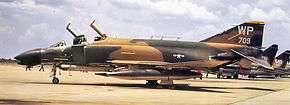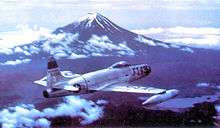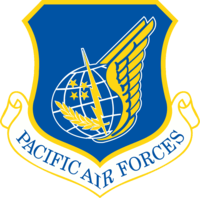35th Fighter Squadron
| 35th Fighter Squadron | |
|---|---|
|
F-16C block 40 #89-2064 from the 35th FS lands at Kunsan AB on 16 March 2010. | |
| Active |
12 June 1917 – 19 March 1919 25 June 1932 – present |
| Country | United States |
| Branch | United States Air Force |
| Type | Fighter |
| Part of |
Pacific Air Forces 7th Air Force 8th Fighter Wing 8th Operations Group |
| Nickname(s) | Pantons |
| Motto(s) | PUSH IT UP! |
| Colors | BLUE |
| Mascot(s) | Bill The Cat |
| Decorations |
|
| Commanders | |
| Current commander | Lt. Col. Christopher Eberth |
| Insignia | |
| 35th Fighter Squadron emblem |
 |
The 35th Fighter Squadron (35 FS) is a United States Air Force unit, assigned to the 8th Operations Group, stationed at Kunsan Air Base, South Korea. The squadron operates the F-16 Fighting Falcon aircraft conducting air superiority missions.
Overview
The 35th FS is one of two squadrons of Block 40 F-16C/Ds of the 8th Fighter wing at Kunsan, flying the Fighting Falcon since 1981. The 35th is one of the oldest squadrons in the United States Air Force, its history dating to 12 June 1917, when the unit was activated as the 35th Aero Squadron.[1]
History
World War I
The 35th Fighter Squadron heritage dates back to 12 June 1917, when the unit activated as the 35th Aero Squadron. Originally an aircraft maintenance squadron, the unit served in France from September 1917 to February 1919. Upon the unit's return to the United States after the armistice, it demobilized during the American disarmament.[2]
Inter-war years
Recognizing the need for a strong air arm, American defense officials reconstituted the squadron in June 1932 and redesignated it the 35th Pursuit Squadron. For the next few years, the 35th flew P-12, PB-2, A-17, and P-36 aircraft out of Langley Field, Virginia. In 1939, the unit was redesignated the 35th Pursuit Squadron (Fighter) and moved to Mitchel Field, New York, to fly the P-40 Warhawk.[2]
World War II
The 35th Fighter Squadron along with the 8th Pursuit Group and 22nd Airbase Group left San Francisco in Convoy Number 2033, escorted by USS New Orleans, for Australia on 12 February 1942 on the Army transport USAT Maui arriving with the convoy at Brisbane, Australia on 5 March 1942.[3] The squadron has never been stationed in the United States since. They arrived in Brisbane, Queensland on 6 March 1942. After arrival, it moved to Amberly Airfield, west of Brisbane, where it was equipped with P-39D Airacobras that were originally intended to go to the Philippines but the convoy was diverted to Brisbane.
They then moved to Woodstock outside of Townsville in Northern Queensland on 26 April 1942 on their way to Port Moresby, New Guinea where they arrived on 30 April 1942. There, the squadron operated from a gravel fighter strip constructed by the Australians in the 1930s called Kila Kila Airfield (3 Mile Drome). After two months in combat, the squadron rotated back to Australia, returning to Woodstock on 29 June 1942 for various rest and re-equipment tasks. They relocated to Garbutt airfield in Townsville on 27 July 1942 and then moved to Milne Bay in New Guinea on 18 September 1942 after the airfield was secured from the Japanese. It again engaged in combat operations against Japanese forces with its P-39s until rotated back to Queensland, being sent to Mareeba Airfield in February 1943 as its Airacobras were basically worn-out. At Mareeba, the squadron was re-equipped with P-40N Warhawks before leaving Australia for good in May and heading back to Port Moresby.
In New Guinea, the squadron covered landings and supported offensive ground operations in New Britain, New Guinea, and Hollandia, with the group moving forward to different bases as territory was captured from the Japanese. At Cape Gloucester, the P-40s were replaced by P-38F Lightnings that were ferried up from Australia. It was with the P-38 that the 8th Fighter Group became truly effective both against the Japanese Zero in air-to-air battles, as well as providing ground support to MacArthur's ground forces. Its twin engines offered an additional safety factory when operating over long stretches of water and jungle. The Lightnings proved to be extremely rugged and could take a lot of battle damage and still keep flying. Missions lasting 9, 10, or even 12 hours became routine, and many wounded Lightnings were able to limp home on only one engine.
In 1944, the 35th supported operations in the Philippines, earning a second Distinguished Unit Citation when, armed only with machine guns, the Lightnings of the 8th Fighter Group strafed a Japanese naval task force for three hours, halting the ships until B-25 medium bombers from more distant bases could attack the task force with low-level bomb runs Despite the fact that the group did not have time to load bombs on its fighters and used only .50 caliber bullets on the mission, the 8th managed to sink one of the Japanese ships.
After moving to San Jose, Occidental Mindoro in the Philippines in December 1944, the 35th spent the next several months conducting offensive operations against Formosa and the Asian mainland, as well as flying escort missions in the area. Moving to a base in Ie Shima in August 1945, the 8th flew several missions against the Japanese island of Kyushu before the war ended.
On 14 August 1945, the day of the Japanese surrender, the 35th Fighter Squadron shot down the last enemy plane of the war. During its involvement in World War II, the 35th participated in nine campaigns.
Korean War
When the Korean War began, the redesignated 35th Fighter Bomber Squadron entered combat. Once on the offensive, the 35th moved from base to base in Korea, flying the F-80 Shooting Star and later the F-86 Sabre. At one time, the 35th was stationed at Pyongyang, now the capital of North Korea.[2]
Pacific Air Forces service
When the Korean War ended, the squadron started flying F-100 Super Sabres at its new location at Itazuke Air Base, Japan. In 1963, the squadron received F-105 Thunderchiefs to replace the F-100s and moved to Yokota Air Base, Japan.[2]
In 1964, the 35th deployed to Korat Royal Thai Air Force Base, Thailand, as one of the first units to fight in Southeast Asia. It later moved to Takhli Royal Thai Air Force Base, Thailand. During this deployment, the squadron's new home became Osan Air Base, Republic of Korea.[2]
On 15 March 1972, the 35th moved to Kunsan Air Base to fly the F-4 Phantom II. In September 1981, the 35th and its sister squadron, the 80th Tactical Fighter Squadron, became the first overseas units to convert to the F-16 Fighting Falcon. The squadrons and wing dropped the "tactical" designation from their titles during an Air Force-wide reorganization on 31 January 1992.[2]
On 17 November 2000, the 35th Fighter Squadron received its first Block 40 F-16s. The new aircraft carry Low-Altitude Navigation and Targeting Infrared for Night, or LANTIRN, pods. The combination of LANTIRN and night-vision goggles allows the squadron to take the fight into the night. The 35th completed the conversion in February 2001.[2]
Lineage



- Organized as 35th Aero Squadron on 12 Jun 1917
- Demobilized on 19 Mar 1919
- Reconstituted, and redesignated 35th Pursuit Squadron, on 24 Mar 1923
- Activated on 25 Jun 1932
- Re-designated: 35th Pursuit Squadron (Fighter) on 6 Dec 1939
- Re-designated: 35th Pursuit Squadron (Interceptor) on 12 Mar 1941
- Re-designated: 35th Fighter Squadron on 15 May 1942
- Re-designated: 35th Fighter Squadron, Two Engine, on 19 Feb 1944
- Re-designated: 35th Fighter Squadron, Single Engine, on 8 Jan 1946
- Re-designated: 35th Fighter Squadron, Jet, on 1 Jan 1950
- Re-designated: 35th Fighter-Bomber Squadron on 20 Jan 1950
- Re-designated: 35th Tactical Fighter Squadron on 1 Jul 1958
- Re-designated: 35th Fighter Squadron on 3 Feb 1992.
Assignments
- Third Aviation Instruction Center (1917–1919)
- 8th Tactical Fighter Wing (1932–1964)
- 41st Air Division (1964–1965)
- Attached: 2d Air Division (24 September – 20 November 1964)
- 6441st Tactical Fighter Wing (1965–1966)
- Attached: 2d Air Division (4 May – 26 June, 19 October – 15 November 1965)
- 41st Air Division (1966–1968)
- 347th Tactical Fighter Wing (1968–1971)
- 3d Tactical Fighter Wing (1971–1974)
- Attached: 366th Tactical Fighter Wing (3 April – 12 June 1972)
- Attached: 388th Tactical Fighter Wing (12 June - c. 12 October 1972)
- 8th Fighter Wing (1974 – present)
Stations
|
|
Aircraft
|
|
Operations
See also
References
![]() This article incorporates public domain material from the Air Force Historical Research Agency website http://www.afhra.af.mil/.
This article incorporates public domain material from the Air Force Historical Research Agency website http://www.afhra.af.mil/.
- Williford, Glen M. (2010). Racing the Sunrise—Reinforcing America's Pacific Outposts 1941—1942. Annapolis, Maryland: Naval Institute Press. ISBN 978-1-59114-956-9. LCCN 2010030455. Retrieved 13 February 2014.
- USAF 35th Fighter Squadron History
- 35th Fighter Squadron Fact Sheet

